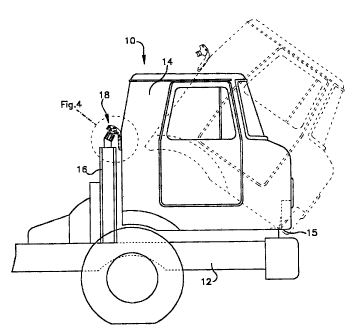Some of the information on this Web page has been provided by external sources. The Government of Canada is not responsible for the accuracy, reliability or currency of the information supplied by external sources. Users wishing to rely upon this information should consult directly with the source of the information. Content provided by external sources is not subject to official languages, privacy and accessibility requirements.
Any discrepancies in the text and image of the Claims and Abstract are due to differing posting times. Text of the Claims and Abstract are posted:
| (12) Patent: | (11) CA 2379466 |
|---|---|
| (54) English Title: | REAR CAB LATCH MECHANISM |
| (54) French Title: | MECANISME DE VERROUILLAGE DE DOS DE CABINE |
| Status: | Expired |
| (51) International Patent Classification (IPC): |
|
|---|---|
| (72) Inventors : |
|
| (73) Owners : |
|
| (71) Applicants : |
|
| (74) Agent: | GOWLING WLG (CANADA) LLP |
| (74) Associate agent: | |
| (45) Issued: | 2008-03-18 |
| (22) Filed Date: | 2002-03-27 |
| (41) Open to Public Inspection: | 2002-10-05 |
| Examination requested: | 2007-01-12 |
| Availability of licence: | N/A |
| (25) Language of filing: | English |
| Patent Cooperation Treaty (PCT): | No |
|---|
| (30) Application Priority Data: | ||||||
|---|---|---|---|---|---|---|
|
An over the highway vehicle having a forwardly pivotal cab mounted on a frame is disclosed. A latch assembly is interposed between the frame and the cab. The latch assembly includes coacting subassemblies including a catch for releasable retention by a latch. One of the subassemblies is connected to the frame and the other of the subassemblies is connected to the cab. The cab connected subassembly includes an impact absorbing yieldable element for normally maintaining a connected cab in a latched position. The element is extensible upon such vehicle experiencing a collision to allow controlled and limited forward tilting of the cab occasioned by the force of such a collision while maintaining the cab in a latched condition. A process of absorbing collision forces is also disclosed.
Un véhicule routier comportant une cabine pivotant vers l'avant sur un châssis est décrit. Un dispositif de verrouillage est interposé entre le châssis et la cabine. Le dispositif de verrouillage comprend des sous-ensembles coopérant, comprenant un loquet de retenue pouvant être libéré par le mécanisme de verrouillage. L'un des sous-ensembles est connecté au châssis et l'autre sous-ensemble est connecté à la cabine. Le sous-ensemble connecté à la cabine comprend un élément d'absorption d'impact déformable pour maintenir normalement une cabine connectée dans une position verrouillée. L'élément est extensible lorsque ledit véhicule entre en collision pour permettre à la cabine de basculer vers l'avant de manière contrôlée et limitée sous l'effet de la force d'une telle collision tout en maintenant la cabine dans un état verrouillé. Un processus d'absorption de forces de collision est également décrit.
Note: Claims are shown in the official language in which they were submitted.
Note: Descriptions are shown in the official language in which they were submitted.

For a clearer understanding of the status of the application/patent presented on this page, the site Disclaimer , as well as the definitions for Patent , Administrative Status , Maintenance Fee and Payment History should be consulted.
| Title | Date |
|---|---|
| Forecasted Issue Date | 2008-03-18 |
| (22) Filed | 2002-03-27 |
| (41) Open to Public Inspection | 2002-10-05 |
| Examination Requested | 2007-01-12 |
| (45) Issued | 2008-03-18 |
| Expired | 2022-03-28 |
There is no abandonment history.
| Fee Type | Anniversary Year | Due Date | Amount Paid | Paid Date |
|---|---|---|---|---|
| Registration of a document - section 124 | $100.00 | 2002-03-27 | ||
| Application Fee | $300.00 | 2002-03-27 | ||
| Maintenance Fee - Application - New Act | 2 | 2004-03-29 | $100.00 | 2003-12-31 |
| Maintenance Fee - Application - New Act | 3 | 2005-03-28 | $100.00 | 2005-02-28 |
| Maintenance Fee - Application - New Act | 4 | 2006-03-27 | $100.00 | 2006-02-16 |
| Request for Examination | $800.00 | 2007-01-12 | ||
| Maintenance Fee - Application - New Act | 5 | 2007-03-27 | $200.00 | 2007-02-16 |
| Final Fee | $300.00 | 2008-01-03 | ||
| Maintenance Fee - Application - New Act | 6 | 2008-03-27 | $200.00 | 2008-02-13 |
| Maintenance Fee - Patent - New Act | 7 | 2009-03-27 | $200.00 | 2009-02-12 |
| Maintenance Fee - Patent - New Act | 8 | 2010-03-29 | $200.00 | 2010-02-18 |
| Maintenance Fee - Patent - New Act | 9 | 2011-03-28 | $200.00 | 2011-02-17 |
| Maintenance Fee - Patent - New Act | 10 | 2012-03-27 | $250.00 | 2012-02-08 |
| Maintenance Fee - Patent - New Act | 11 | 2013-03-27 | $250.00 | 2013-02-13 |
| Maintenance Fee - Patent - New Act | 12 | 2014-03-27 | $250.00 | 2014-02-14 |
| Maintenance Fee - Patent - New Act | 13 | 2015-03-27 | $250.00 | 2015-03-09 |
| Maintenance Fee - Patent - New Act | 14 | 2016-03-29 | $250.00 | 2016-03-07 |
| Maintenance Fee - Patent - New Act | 15 | 2017-03-27 | $450.00 | 2017-03-22 |
| Maintenance Fee - Patent - New Act | 16 | 2018-03-27 | $450.00 | 2018-03-16 |
| Maintenance Fee - Patent - New Act | 17 | 2019-03-27 | $450.00 | 2019-03-20 |
| Maintenance Fee - Patent - New Act | 18 | 2020-03-27 | $450.00 | 2020-04-01 |
Note: Records showing the ownership history in alphabetical order.
| Current Owners on Record |
|---|
| VOLVO TRUCKS NORTH AMERICA, INC. |
| Past Owners on Record |
|---|
| PEDDYCORD, JEFF |
| PHILIPPS, DAVID |